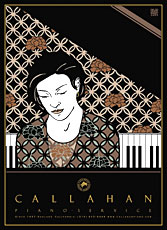Edition of 2857 of which 125 copies are signed 1-125, 26 copies are signed A-Z as artist's proofs. 51 copies signed as dedication copies.
Three sets of progressives.
December 2, 2003
8 colors 17-1/2 x 24
Client: John Callahan, Callahan
Piano Servce, 662 Arimo Avenue, Oakland CA 94610
Telephone: (510) 835-8448 e-mail
www.callahanpiano.com
Model: Lydia Gabrielle Hoffman
1-125: Saint Hieronymus Press Dedication copies: Lydia Gabrielle Hoffman, et al.
Artist's Proofs: Saint Hieronymus Press
Progressives: One set to Lydia Gabrielle Hoffman, two sets to Saint Hieronymus Press
When I was a boy, the distinction between the genteel home and lesser dwellings was the presence of a piano. Preferably a piano in the parlor, which was a special room in the genteel home the purpose of which was to house the piano and to entertain guests. This room was not actually lived in the way a bedroom or kitchen or even a living room was lived in, but was reserved for special occasions: When the minister visited, he was entertained in the parlor. Daughters sat in the parlor with their beaux, under, or at least uncomfortably near, the vigilant parental eye. The parlor was not part of the house that the family lived in, it was the part of the house that the family did not live in, and that formal visitors did not go beyond. If you were such a visitor, you came in by the front door and sat in the parlor, If you were part of the family, or an intimate of the family, you came in by the kitchen door, and did not go in by the front door or sit in the parlor except on special occasions.
In my family, great-grandmother, grandmother, mother, and all four of the daughters--Lisa, Deborah, Elisabeth and Sarah--played the piano and the whole family gathered around and sang. We sang Stephen Foster's interpretations of Negro Spirituals, traditional Irish ballads and Civil War songs on my great-grandmother's side; cowboy hollers and worksongs on my grandfather's side; Gilbert and Sullivan, Broadway show tunes and popular music from the 'thirties and 'forties under our parents' influence; and whatever else we picked up along the way, memorized from records or learned from friends. Singing was something we did a lot of, and if there was a piano around, which there usually was, it made it all the merrier. A piano and a parlor were in the same important class as lace curtains. They marked you as a member of the middle class, or at least of the rising working class.
A piano, a parlor and lace curtains were things that you did not need in order to live, but which, like indoor plumbing, made life more pleasant. They meant you had a little something to spare; that you weren't living too close to the bone of life, but rather in the plumper part. The next step up would be cut flowers in the house--even though no one was dead. We never went that far, as I recollect.
